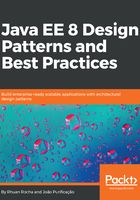
Implementing the Session Façade pattern in JEE
In the JEE architecture, Session Fa?ade is implemented by a stateless or stateful EJB. An EJB object can use or combine other POJOs, business objects, and EJBs. At this point, we must be careful not to accumulate too many unnecessary layers, as we run the risk of having a chain of EJBs where one EJB calls another more internal EJB, and so on. The services must be mapped and designed well.
Because the Session Fa?ade is primarily implemented by EJBs, services such as transaction-control and security-management come naturally to this technology. It is in this layer that we usually have the transaction-control of most internal objects, such as the POJOs, which represent entities within the JPA technology. For an EJB, JPA entity transaction control is native, meaning that it is supplied by the JEE container. This provides a large increase in productivity during development.